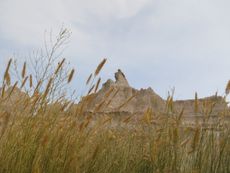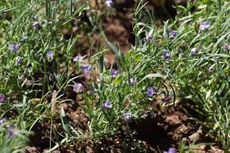Orchardgrass Information: Orchardgrass Uses In The Landscape


Orchardgrass is native to western and central Europe but was introduced to North America in the late 1700’s as pasture hay and forage. What is orchardgrass? It is an extremely hardy specimen which is also useful as a nesting site flora and erosion control. Wild and domesticated grazing animals find the grass palatable. It has been classed as a restricted noxious weed in Delaware, New Jersey, Pennsylvania, Maryland, Virginia, and West Virginia but is widely grown across the country as part of a careful crop rotation program.
What is Orchardgrass?
Orchardgrass uses span more than erosion, fodder, hay, silage, and natural ground cover. It also enhances the nitrogen in soil when planted deep with abundant water. As manure and biosolids, it returns high levels of this necessary macronutrient to the soil. There are a wide variety of orchardgrass growing conditions suitable for this tolerant plant. Orchardgrass is also known as cocksfoot. It is a cool-season, perennial bunching grass. What does orchardgrass look like? This true grass can grow 19 to 47 inches (48.5 to 119.5 cm.) in height with leaf blades up to 8 inches (20.5 cm.) in length. Leaves are broadly tapered to a point and the base is v-shaped. Sheaths and ligules are smooth and membranous. The inflorescence is a panicle up to 6 inches (15 cm.) long with two to five flowered spikelets in dense side clusters. It germinates early in the season and achieves the bulk of its growth in the cooler season.
Orchardgrass Information
Among the better orchardgrass uses is its ability to add nitrogen to the soil. Crucial to farmers regarding this bit of orchardgrass information is that it enhances the soil and nutrient content of hay even more when combined with legumes or alfalfa. If planted alone, the grass is harvested early in the season, but when combined with legumes, it is harvested when the legume is in late bud to early bloom for the most nutritious hay or silage. Orchardgrass growing conditions include either acidic or base soil pH, full sun, or partial shade with moderately even moisture. It is found in disturbed areas, savannas, woodland borders, orchards, pastures, thickets, and fence rows. Provided site conditions are correct, it is easy to establish and durable. The plant even withstands cold winters to -30 F. (-34 C.) if insulated by snow. Grass planted for erosion control is seeded or drilled in late summer to early autumn but that established for forage is planted in late winter to early spring. This provides the more tender shoots with the highest nutrition available for browsing animals. The time for harvesting the plants depends upon the use. Harvest in early to mid-spring for hay. As tillage, it is turned under in late winter. If the grass is to be grazed, grazing can start in early spring until summer but late-season grazing should be discouraged. Leave some of the plants to form mature seed heads and allow them to reseed for a consistent supply of the plants. With careful management, orchardgrass can perform a host of functions while adding nutrients and tilth to soil.
Gardening tips, videos, info and more delivered right to your inbox!
Sign up for the Gardening Know How newsletter today and receive a free download of our DIY eBook "Bring Your Garden Indoors: 13 DIY Projects For Fall And Winter".

Bonnie Grant is a professional landscaper with a Certification in Urban Gardening. She has been gardening and writing for 15 years. A former professional chef, she has a passion for edible landscaping.
-
 What Is Indirect Light? Grow Plants In Partial Or Filtered Light
What Is Indirect Light? Grow Plants In Partial Or Filtered LightGardeners are often confused about what indirect light and indirect sunlight mean when situating a plant. A little filtering makes all the difference.
By Tonya Barnett
-
 8 Flowering Shrubs You Must Prune Before Winter Ends For Maximum Blooms This Summer
8 Flowering Shrubs You Must Prune Before Winter Ends For Maximum Blooms This SummerMany summer-flowering shrubs should be trimmed before winter ends, so don’t wait. Get out there on a sunny day and prune your shrubs for more flowers and healthy growth in spring and summer.
By Mary Ellen Ellis
-
 Best Late Summer And Early Fall Cover Crops
Best Late Summer And Early Fall Cover CropsPlanting cover crops is a gift you can give to your garden’s soil. Read on to learn about planting cover crops in late summer.
By Bonnie L. Grant
-
 Sunn Hemp Plant Info – Learn Sunn Hemp Uses And Care
Sunn Hemp Plant Info – Learn Sunn Hemp Uses And CareSunn hemp grass is a warm weather grass. Click to learn more about Sunn hemp uses as well as helpful tips on growing Sunn hemp as a cover crop.
By Mary H. Dyer
-
 Native Cover Crops: Vegetable Cover Cropping With Native Plants
Native Cover Crops: Vegetable Cover Cropping With Native PlantsAre there any benefits to using native plants as cover crops? Click here to learn more about vegetable cover cropping with native plants.
By Laura Miller
-
 What Is Field Brome – Information About Field Brome Grass
What Is Field Brome – Information About Field Brome GrassField brome grass can be used as a cover crop to control erosion and enrich the soil. For more information, click the following article.
By Laura Miller
-
 What Is Western Wheatgrass – How To Grow Western Wheatgrass
What Is Western Wheatgrass – How To Grow Western WheatgrassWheatgrass is native to North America and graces the Southwest, Great Plains and mountainous regions of the western U.S. It has some erosion control benefits but using western wheatgrass for grazing is the primary purpose. Learn more about it here.
By Bonnie L. Grant
-
 What Is Chickling Vetch – Growing Chickling Vetch For Nitrogen Fixing
What Is Chickling Vetch – Growing Chickling Vetch For Nitrogen FixingWhat is chickling vetch? Also known by various names such as grass pea, white vetch, blue sweet pea, Indian vetch, or Indian pea, chickling vetch is a nutritious legume grown to feed livestock and humans in countries around the world. Learn more about the plant here.
By Mary H. Dyer
-
Establishing Kura Clover: Learn How To Grow Kura Clover Plants
You no doubt have heard about the four-leaf clover, but few gardeners are familiar with kura clover plants. Kura is a forage legume and if you are interested in growing kura as a groundcover or establishing kura clover for some other use, this article will help.
By Teo Spengler
-
 What Are Austrian Winter Peas: A Guide To Growing Austrian Winter Peas
What Are Austrian Winter Peas: A Guide To Growing Austrian Winter PeasWhat are Austrian winter peas? Also known as field peas, Austrian winter peas have been grown around the world for centuries, primarily as a valuable source of nutrition for humans and livestock. Click this article for info on growing Austrian winter peas.
By Mary H. Dyer